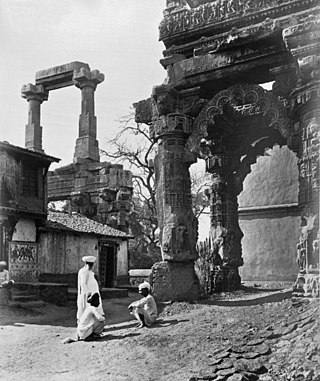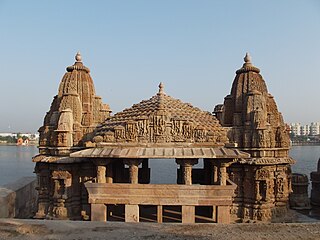
Patan is the administrative seat of Patan district in the Indian state of Gujarat and is an administered municipality. It was the capital of Gujarat's Chavda and Chaulukya dynasties in medieval times, and is also known as Anhilpur-Patan to distinguish it from Prabhas Patan. During the rule of Gujarat Sultanate, it was the capital from 1407 to 1411.
Dholka is a city and municipality in the Ahmedabad District of the Indian state of Gujarat. It is the headquarters of Dholka Taluka, and is 48 km by road via National Highway 8A southwest of the city of Ahmedabad. Dholka has an average elevation of 17 metres (56 ft).

Palanpur is a city and a municipality of Banaskantha district in the Indian state of Gujarat. Palanpur is the administrative headquarters of Banaskantha district. Palanpur is the ancestral home to an industry of Indian diamond merchants.
Prabhas Patan, also known as Somnath Patan or Prabhas Kshetra, historically named Dev Patan, is an suburbs area situated in Veraval, Gir Somnath district in Saurashtra region of Gujarat, India. Somnath temple, a place of pilgrimage due to its importance as Jyotirlinga site dedicated to Shiva, is located here.

Kumarapala was an Indian king from the Chaulukya (Solanki) dynasty of Gujarat. He ruled present-day Gujarat and surrounding areas, from his capital Anahilapataka.

Siddhpur, also spelled Sidhpur, is a town, municipality and headquarter of Sidhpur taluka in Patan district, in the Indian state of Gujarat. It is a historical place located on the bank of the endorheic Saraswati River, which is probably a remaining of the ancient Sarasvati River.
Karna was an Indian king from the Chaulukya (Solanki) dynasty of Gujarat. He ruled the present-day Gujarat and surrounding areas, from his capital Anahilapataka.

The Sahasra Bahu temples or Sasbahu Temples, at Nagda, Rajasthan, are a pair of late 10th-century Hindu temples dedicated to Virabhadra. They share a platform, facing the temple tank, and are similar in style, but one is rather larger than the other. The larger one is surrounded by ten subsidiary shrines, the smaller by four; only the bases remain of some of these. The temples have many of the characteristics of slightly later Māru-Gurjara architecture but lack others, especially in the plan and exterior sculpture.
Jasma Odan is a folk deity from medieval Gujarat about a woman who committed sati to protect her honor after her husband was murdered by Siddharaj Jaisinh, a king of Chaulukya dynasty.

Rani Ki Vav is a stepwell situated in the town of Patan in Gujarat, India. It is located on the banks of the Saraswati River. Its construction is attributed to Udayamati, the spouse of the 11th-century Chaulukya king Bhima I. Silted over, it was rediscovered in the 1940s and restored in the 1980s by the Archaeological Survey of India. It has been listed as one of the UNESCO World Heritage Sites in India since 2014.

Brahma Kund is a stepped temple tank in Sihor town of Bhavnagar district, Gujarat, India. It is located near the southern wall of the old town. It believed that it was constructed by Jayasimha Siddharaja.
Jayasiṃha, who assumed the title Siddharāja, was an Indian king who ruled western parts of India. He was a member of the Chaulukya dynasty.

The Rudra Mahalaya Temple, also known as Rudramal, is a destroyed/desecrated Hindu temple complex at Siddhpur in the Patan district of Gujarat, India. Its construction was started in 943 CE by Mularaja and completed in 1140 CE by Jayasimha Siddharaja, a ruler of the Chaulukya dynasty. The Hindu temple was destroyed by the Sultan of Delhi, Alauddin Khalji, and later the Sultan of Gujarat, Ahmed Shah I (1410–1444) desecrated and substantially demolished the temple, and also converted part of it into the congregational mosque of the city. Two torans (porches) and four pillars of the former central structure still stand along with the western part of the complex used as a congregational mosque.
Stepwells are wells in which the water is reached by steps. They are most commonly found in western India especially Gujarat where over 120 such wells are reported. The origin of the stepwell may be traced to reservoirs of the cities of the Indus Valley civilization such as Dholavira and Mohenjo-daro. The stepwells were constructed in the south western region of Gujarat around 600 AD. From there they spread north to Rajasthan and subsequently to north and west India. Construction activities accelerated during the tenth to 13th century during the Chaulukya and Vaghela periods. The construction of these stepwells hit its peak during the 11th to 16th century. The Muslim rulers of the 13th to 16th century did not disrupt the culture that was practiced in these stepwells and encouraged the building of stepwells. The wells lost their significance in the 19th century due to introduction of water pumps and pipe-systems.

Madana-Varman was a king of the Chandela dynasty of India. He succeeded his father Prithvi-Varman as the ruler of the Jejakabhukti region. He revived the Chandela glory by subduing the neighbouring kingdoms, and commissioned several tanks and temples.
Durlabha-raja was an Indian king who ruled parts of present-day Gujarat from his capital at Anahilapataka. He was a member of the Chaulukya dynasty.
Khengara was a Chudasama king of Saurashtra region of western India who reigned in the 12th century. His capital was at Junagadh. He was a contemporary of Jayasimha Siddharaja, the Chaulukya ruler of Anahilapataka. According to bardic tales, he was a son of Navaghana and had succeeded him.
Ranakadevi was a legendary 12th century queen of Khengara, the Chudasama ruler of Saurashtra region of western India. She is mentioned in the bardic tragic romance representing the battle between Chudasama king Khengara and Chaulukya king Jayasimha Siddharaja. However, this legend is not credible.

Munsar Lake is water body constructed by Minaldevi, mother of Jayasimha Siddharaja, of Chaulukya dynasty. It was named as Mansavor but due to Indiscretion it's widely known as Munsar. This lake is situated at Viramgam, near Ahmedabad.

Ranakdevi's Temple is a 9th or 10th century Hindu temple dedicated to Ranakdevi located in Wadhwan in Surendranagar district of Gujarat, India. It is built in post-Maitraka and early Nagara phase of Māru-Gurjara architecture style.





















